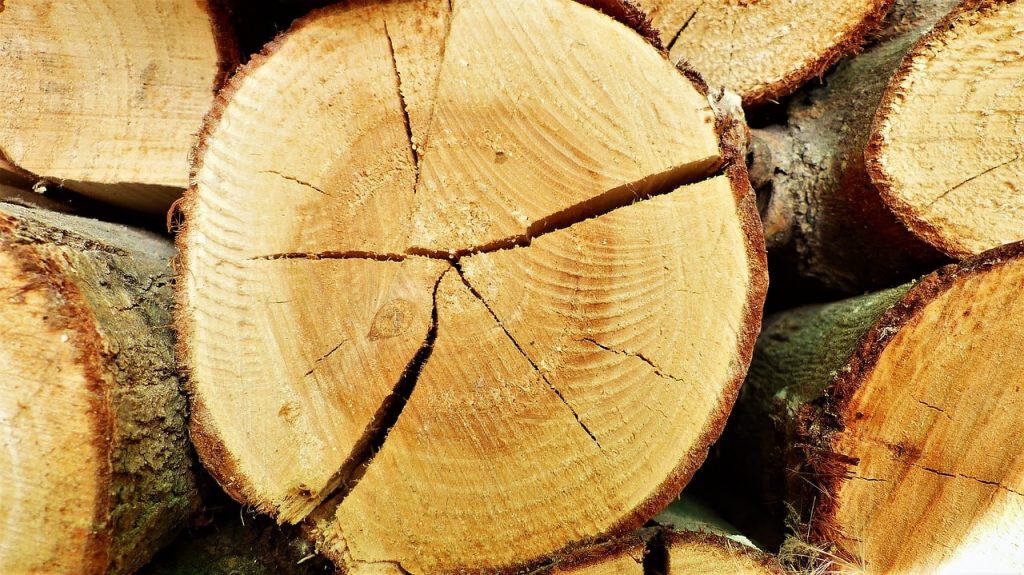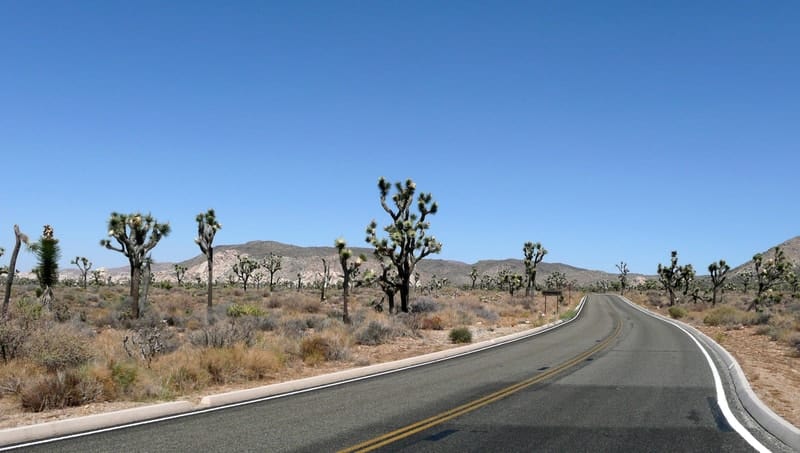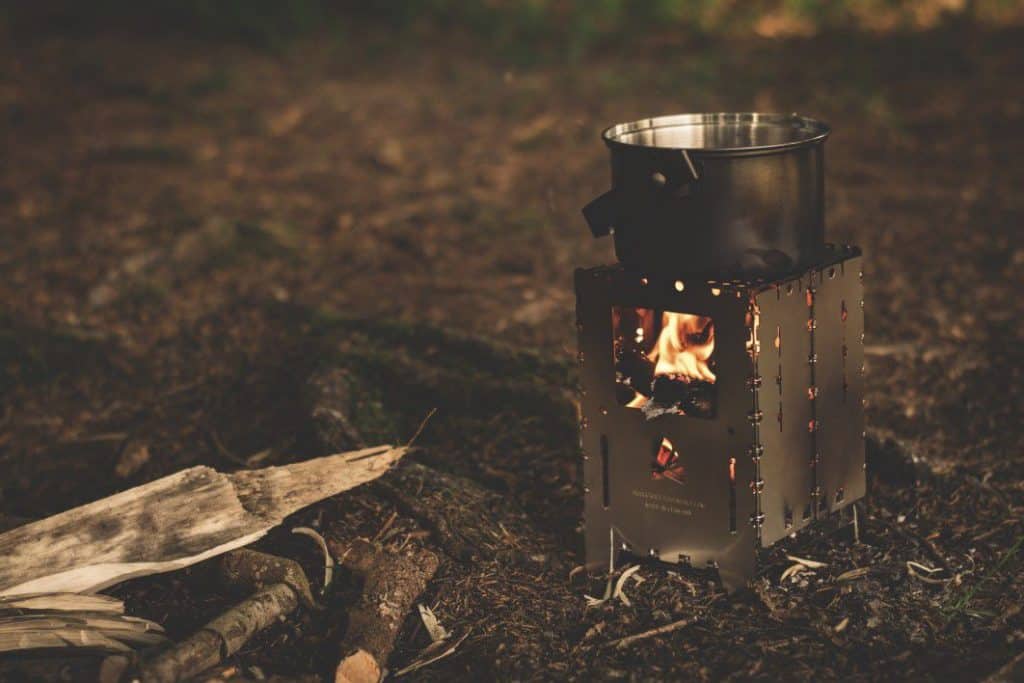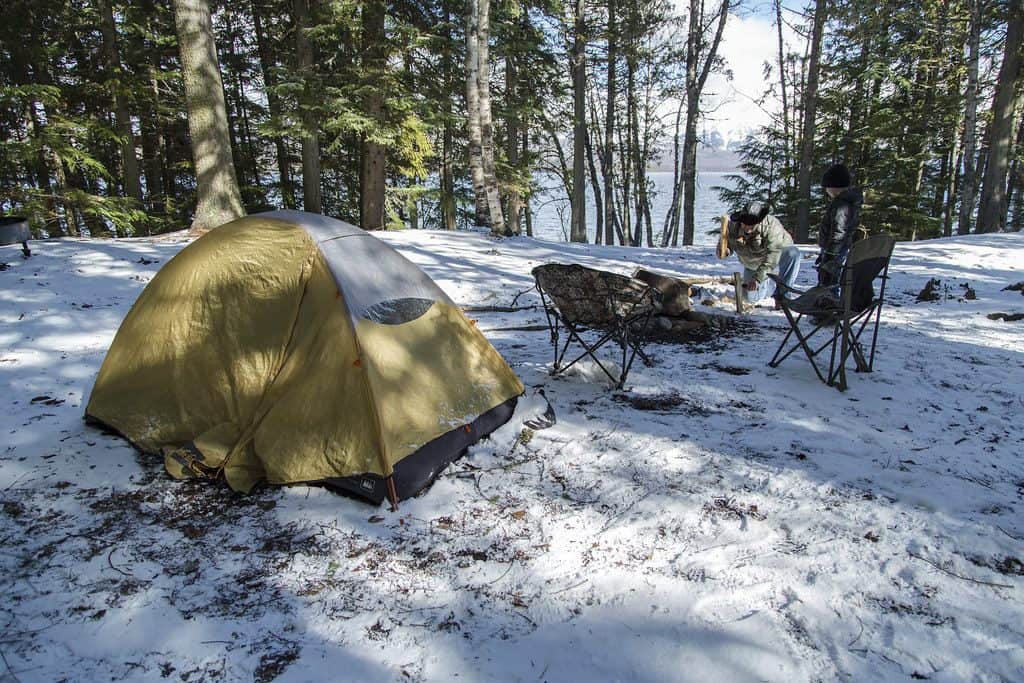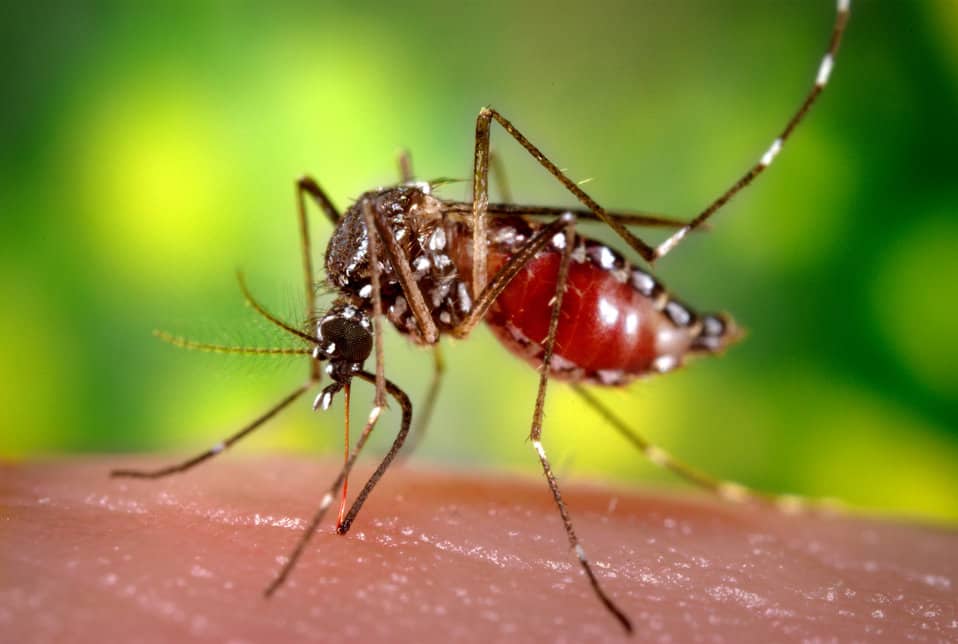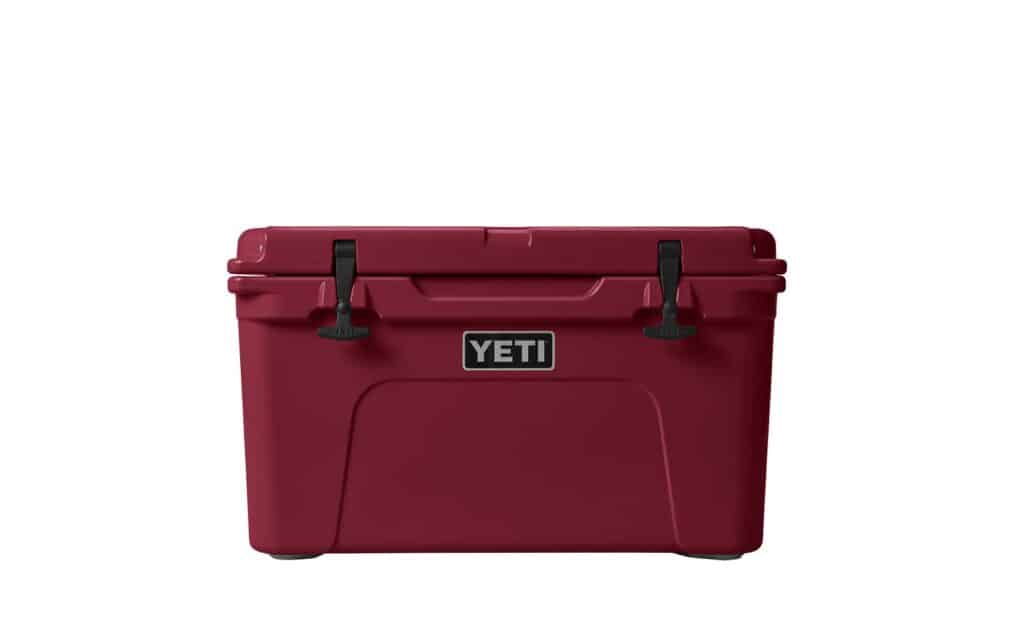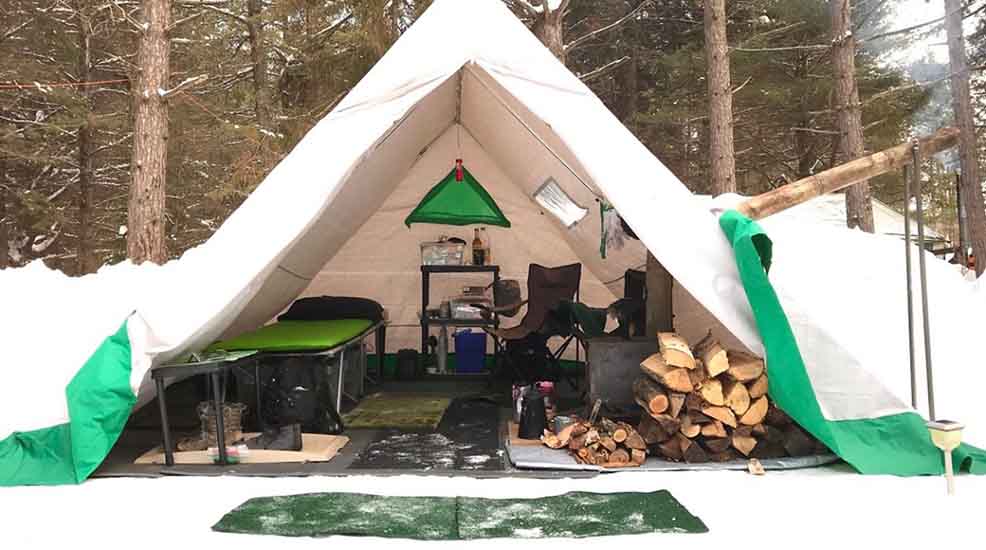
Are you looking to wake up to a warm shelter, enjoy nature without freezing and stay cozy no matter the weather when you are out camping? We have a solution for you: hot tent camping (hot tenting)!
What Is Hot Tent Camping?
Hot tenting refers to camping in cold weather using a tent equipped with a wood-burning stove. The stove provides heat to keep the tent’s interior warm and comfortable.
It is a practical and innovative camping technique involving a tent equipped with a stove to create a heated living space in cold winter. Unlike traditional camping, a hot tent integrates a stove inside the tent, offering warmth and comfort beyond mere shelter. Using this method, I shielded against extreme cold and had an enjoyable way to experience winter camping.
It also prevents hypothermia, ensuring a safe and positive outdoor adventure while encouraging longer stays in nature. Methods and equipment vary, from wood-burning to propane stoves and tents of different sizes and materials, catering to diverse preferences.
Beyond comfort, using hot tent variations fosters camaraderie and allows activities difficult in cold weather. It enhances the camping experience and reduces environmental impact through self-sufficient wood-burning stoves. This approach reconnects individuals with nature during colder months, combining technology and tradition for a safe and comfortable winter camping adventure.
The guide further explores equipment selection and techniques, facilitating a rewarding experience. We will cover the benefits of hot tenting and the types of tents and stoves available. Moreover, we’ll talk about how to set up and operate your equipment safely and give tips for staying warm at night and packing efficiently.
Whether you are a seasoned winter camper looking to level up your experience or new to camping in cold weather, this comprehensive guide will ensure a safe, enjoyable adventure.
By the end of this article, you will have the confidence and know-how to get out there, battle the elements, and stay toasty in your hot tent.
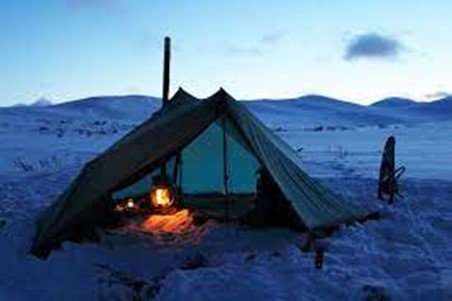
Why Hot Tent Camping?
A hot tent provides several benefits over traditional tent camping.
# 1 – Extended Camping Season
Hot tents allow you to comfortably camp in colder weather by containing the heat from a stove. This means you can get out for more of the year and avoid crowds during the peak summer season. With the right gear, a hot tent can extend your camping season into the winter.
# 2 – Protection from the Elements
Hot tents shield you from wind, rain, and snow. The canvas material and stove protect you from precipitation and help block drafts. You will stay warm and dry no matter what the weather is outside.
# 3 – Increased Efficiency
A hot tent focuses the heat from your stove to efficiently warm the space. This allows you to cook meals, boil water, and dry gear more easily. You can accomplish in minutes what would take much longer over an open fire.
# 4 – Comfort
Perhaps the greatest benefit of using a hot tent is the comfort of camp. A roaring fire in a wood-burning stove and warm tent can make for cozy evenings playing cards or reading by lantern light.
You will sleep soundly in a heated tent, waking up rejuvenated for the day’s adventures. You can even take your hot tent backpacking around if the weight is manageable, making it convenient and portable.
With the benefits of extended camping time, protection from the elements, increased efficiency, and comfort, it is easy to see why hot tents have become popular. If you are an avid camper looking to get out more and in greater comfort, a hot tent could be just what you need.
Types Of Hot Tents And Stoves
There are two main types of hot tents: traditional canvas tents and modern lightweight tents. You can choose the one that depends on your needs and preferences and a reasonable hot tent price.
# 1 – Traditional Canvas Tents
Canvas tents are durable and weather-resistant. Made of heavy cotton canvas, they offer excellent insulation and stand up well to wind and rain. However, canvas tents are heavy, difficult to set up, and expensive. They are best for long-term or permanent camps.
# 2 – Modern Lightweight Tents
Lightweight tents are made of synthetic fabrics like nylon or polyester. They are more affordable, easier to set up and transport than canvas tents. However, they may not insulate as well and can deteriorate more quickly. Popular lightweight tent styles in hot tent variations include:
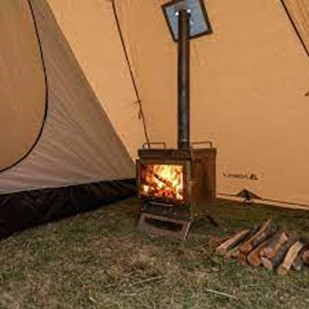
- Tipis: Tall, cone-shaped tents with a fire-resistant opening at the top. Easy to set up but with limited interior space.
- Pyramid tents: A-frame tents that are very stable in the wind. Spacious interior but can be challenging to heat efficiently.
- Dome tents: Very stable and wind resistant. Easy to heat but with limited headroom. Best for a short-term camping trip.
For heating, you will need a hot tent stove. The two most common types are wood-burning stoves and propane/gas stoves. Wood stoves can run longer, but propane stoves are more convenient. Please make sure any stove you use is properly ventilated and never left unattended when burning.
With some planning, living in a hot tent can be a fun and memorable experience. Choose a tent and stove appropriate for your needs, be safe, and enjoy this cozy way to camp!
How To Set Up a Hot Tent?
Location
Choose a flat area that is sheltered from the wind. Look for natural features like large trees, bushes, or terrain that can block the wind. If there are no natural shelters, you may need to set up a windbreak. A slope facing away from the wind is also ideal. The location should have adequate space for guy lines and stakes.
Check if there are any fire bans in effect and if open flames are permitted. Select a site at least 200 feet away from overhanging branches. Clear the area of any debris that could catch fire.
Hot Tent Setup Steps:
- Lay out all the tent components and organize them into groups: tent body, poles, stakes, guy lines, flysheet, vestibule, etc. This will make the hot tent conversion easier for you.
- Assemble the tent poles and attach the tent body. Most hot tents use a basic A-frame design with two long poles that cross at the top. Extend the poles to their full length and insert the ends into the pole sleeves or grommets in the tent body.
- Attach the guy lines to the tent and stakes. Guy lines provide stability by securing the tent to stakes in the ground. Attach guy lines to the tent pole intersections, peaks and walls. Drive stakes into the ground at a 45° angle about 6 to 8 feet from the base of the tent.
- Install the flysheet and vestibule. The flysheet protects the tent from rain and snow. Attach the flysheet over the tent body and guy out for maximum coverage. A vestibule can provide additional covered storage space. Attach the vestibule to the front of the flysheet and guy out the sides.
- Ensure proper ventilation. For safety, hot tents require adequate ventilation, especially if using a stove. Open multiple vents and windows to increase airflow. Consider an exhaust vent or opening at the top of the tent.
- Install a stove on a heat shield. Always follow the manufacturer’s instructions for safe installation and use. Ensure there is adequate clearance around the stovepipe for ventilation. Install a heat shield under the stove to protect the tent floor.
- Test all parts to be securely installed before using the hot tent. Double-check that the tent is properly ventilated and the stove is safely installed before operating.
Safety Guidelines for Hot Tents
When in a hot tent, safety should be your top priority. Follow these guidelines to avoid injury or damage.
# 1 – Proper Ventilation
Make sure there is always adequate ventilation in your tent. Keep multiple vents and windows open to allow for airflow and prevent carbon monoxide buildup. Run a battery-powered fan if possible.
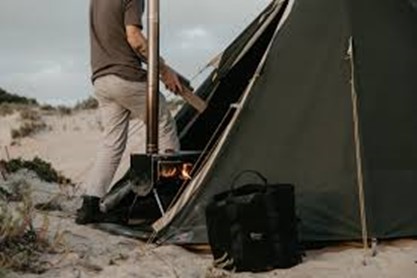
# 2 – Fire Safety
Never leave a fire unattended. Keep a fire extinguisher, sand, water, or other fire retardant nearby in case of emergencies. Clear the area around your tent and fire pit of any debris that could catch fire. Choose a tent material that is fire-resistant or treated with a flame-retardant. Synthetic fabrics like nylon can melt in high heat. Cotton canvas tents are a good choice for a hot tent.
# 3 – Carbon Monoxide Awareness
Carbon monoxide (CO) is an odorless, colorless gas that can be lethal in high concentrations. Early symptoms of CO poisoning include headaches, dizziness, and nausea. Ensure there are CO detectors in your tent and someone will wake up if an alarm sounds. Keep multiple vents open for airflow; never run a generator, grill, or stove inside your tent. In my opinion, investing in a hot tent with windows makes things easier and safer.
# 4 – Safe Distance from Combustible Materials
Keep your tent at least 10 to 15 feet away from any trees or bushes. Move any dead or dying vegetation away from the area. Do not set up your tent in a location with overhanging branches that could catch fire.
Clear the ground of any debris like pine needles, leaves, or brush that could pose a fire hazard before setting up your tent. Bury ashes and coal, or pack them out when leaving the site to avoid post-fire flare-ups.
By following best practices for fire safety, ventilation, and carbon monoxide awareness, you will ensure an enjoyable experience free from danger. Take the necessary precautions and be vigilant about monitoring your fire and the conditions in and around your tent. Your safety depends on it.
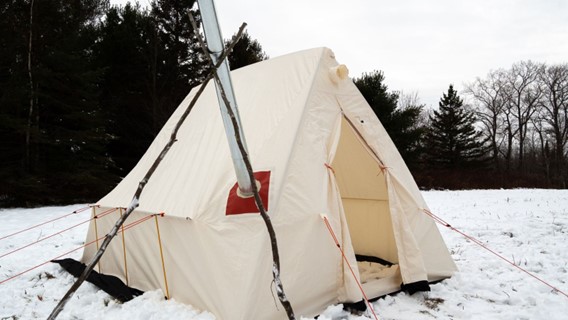
Tips for Effective Hot Tent Camping
Once you set up your hot tent, there are a few tips and tricks to remember for an enjoyable experience.
# 1 – Fuel Choice and Management
The type of fuel you choose for heating and cooking in your tent is important for safety, effectiveness, and minimizing moisture. Propane is a popular choice as it is relatively odorless and efficient. Ensure to ventilate and never run a fuel stove continuously – only when needed. Keep fuel canisters outside and properly sealed to avoid spills or leaks.
# 2 – Cooking Inside the Hot Tent
Cooking inside a hot tent requires caution but with the right precautions, it can be very cozy. Use a hot tent stove jack with a secure base, avoid open flames, and never leave cooking food unattended. Keep a fire extinguisher handy in case of emergencies. Crack tent windows or vents to provide ventilation and prevent the buildup of dangerous fumes.
# 3 – Managing Moisture and Condensation
Moisture management is key to hot tent comfort. Ventilate the tent, especially while cooking or if many people are inside. Open windows, doors, and vents to allow humid air to escape and prevent condensation buildup. Wipe down tent walls with a towel to absorb excess moisture. Avoid overheating the tent, which can lead to excess sweating and condensation.
# 4 – Clothing and Footwear
Dress in breathable, moisture-wicking layers for hot tenting. Remove outer layers as needed to avoid overheating while still staying warm. Insulated boots, slippers, or thick socks are recommended for walking around on cold ground. Keep an extra pair of a hot tent and gear such as gloves, dry socks, and other thermals handy if the ones you wear get damp from moisture or snow.
Following these tips will help ensure you have a safe, cozy, and enjoyable experience. By properly managing hot tenting accessories like fuel, ventilation, cooking, and moisture, you can stay warm all night without worry.
Conclusion
You now have all the knowledge needed to get started with hot tenting. Whether you want to stay warm while winter camping or experience the coziness of a canvas shelter, hot tents offer a unique way to connect with nature. By choosing the right tent, preparing properly, and following safety best practices, you’ll be well on your way to successful camping adventures.
I absolutely think the rewards of waking up warm in a sea of white, making meals over an open fire, and bonding over stories under a glowing lantern make any challenges worthwhile.
Andrea is passionate about going on adventures and enjoys spending quality time with her loved ones, whether it’s hiking through the mountains or camping by the lake.

